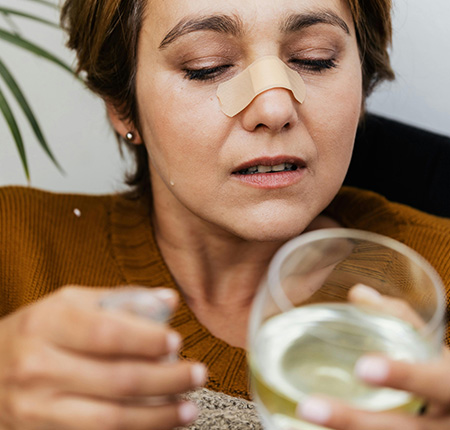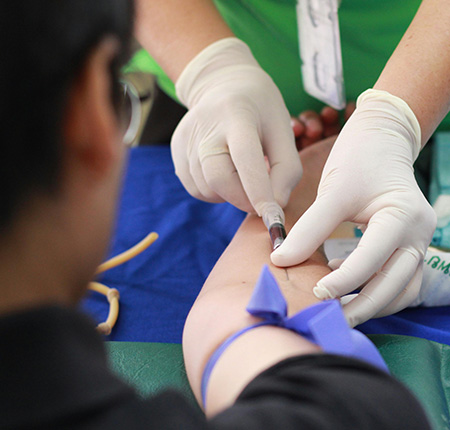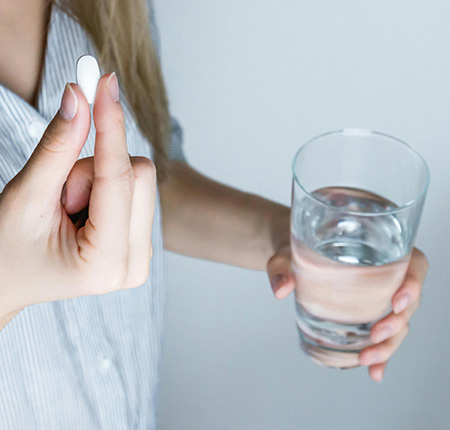
Do you feel tired and lack energy even though you've had enough rest? Does your skin look pale and your hair seems to be falling out more than usual? All of these could be signs of an iron deficiency in the body.
Iron deficiency is one of the most common nutritional deficiencies, affecting millions of women worldwide. In 2023, estimates showed that almost 40% of women participating in the study (PMID: 37367984) suffered from an iron deficiency. Read the article and discover what the symptoms of iron deficiency are, but also how you can effectively correct it through diet and treatment.
What is iron and what is its role in the body?
Iron is a metal that is abundant in nature, but is also found in the human body. In humans, iron is one of the essential minerals for the proper functioning of the body.
A key role of iron is to help produce important molecules such as hemoglobin and myoglobin. These two proteins carry oxygen to all cells in the body. Hemoglobin is found in red blood cells and carries oxygen from the lungs through the bloodstream. Myoglobin carries oxygen to muscle tissue.
When tissues are properly oxygenated, they support the immune system, cardiovascular system, and cognitive functions. Without enough iron, tissues and organs do not receive the oxygen they need to function optimally.
Iron also plays an important role in the nervous system, performing numerous functions such as those that support the formation of neural networks and the myelin layer.
Last but not least, iron plays an essential role in supplying the fetus with nutrients and oxygen during pregnancy. This is why, as the pregnancy progresses, the iron requirement for expectant mothers increases.

What does iron deficiency mean?
Iron deficiency occurs when the body does not receive or absorb enough iron to produce a normal amount of hemoglobin. This nutritional deficiency is characterized by low iron stores, insufficient to meet the body's needs for optimal functioning.
The difference between iron deficiency and iron deficiency anemia
Iron deficiency can also involve iron deficiency anemia, but the two terms are not the same. The body can have a mild iron deficiency without also suffering from iron deficiency anemia.
Iron deficiency simply refers to a decrease in iron stores in the body, without this yet affecting the level of hemoglobin in the blood.
Iron deficiency anemia, on the other hand, occurs when iron deficiency is severe enough to decrease hemoglobin production, which affects the blood's ability to carry oxygen.
Essentially, anemia is the result of untreated iron deficiency. That's why it's important to detect iron deficiency early and effectively correct it to prevent it from progressing to anemia and other complications.
Causes of iron deficiency
Iron deficiency can occur for several reasons, and these are divided into several categories. An unbalanced diet, heavy menstruation, pregnancy or certain digestive disorders can lead to a decrease in iron reserves in the body over time. Here are the main causes:
Low iron diet
Lack of dietary sources of iron is one of the most common causes of iron deficiency. If the daily diet does not contain enough iron-rich foods, such as red meat, fish, eggs, legumes, greens or fortified cereals, the body cannot absorb and maintain its iron stores at an optimal level.
Iron deficiency due to heavy menstruation
One of the main reasons why women are more prone to iron deficiency anemia is menstruation, especially heavy periods. Menorrhagia is a common cause of iron deficiency during the fertile period, as the monthly loss of large amounts of blood causes hemoglobin levels to drop and iron stores to deplete.
If you notice heavy menstrual bleeding, accompanied by large clots or lasting more than 7 days, it is important to talk to your gynecologist. In parallel, you can choose menstrual products with 100% organic cotton and a high level of absorption, which will provide you with reliable protection and comfort even on days with heavy flow.
Iron deficiency due to pregnancy
In pregnant women, the body's need for iron increases significantly. The body uses iron reserves to support the development of the fetus, which is why expectant mothers are at a higher risk of iron deficiency.
The risk of deficiency due to this cause and specific symptoms may be lower in early pregnancy , but increases especially in the second and third trimesters. Without adequate iron intake, feelings of extreme fatigue, dizziness and even anemia may occur.
Iron deficiency due to blood loss
Any significant blood loss, whether obvious or hidden, can lead to a decrease in iron levels in the body. People who donate blood, have frequent nosebleeds, heavy menstruation, or major surgery, as well as people who suffer from digestive bleeding (such as stomach or intestinal ulcers) are prone to iron deficiency.
When there are injuries, trauma, or other conditions that result in large amounts of blood loss, the body quickly uses up its iron reserves to produce new red blood cells. If dietary intake is not sufficient, deficiency occurs.

Iron deficiency due to malabsorption
Even if dietary intake is adequate, sometimes the body fails to absorb iron effectively.
Iron is mainly absorbed in the upper part of the small intestine. When this area is damaged, proper absorption can be difficult. This phenomenon is especially common in people who have undergone bariatric surgery or who suffer from conditions such as celiac disease, irritable bowel syndrome, autoimmune gastritis, or Helicobacter pylori infection.
Also, excessive consumption of coffee, green tea, or foods rich in calcium can reduce the body's ability to absorb iron effectively.
Iron deficiency due to a vegetarian/vegan diet
A vegetarian or vegan diet does not automatically mean that you are iron deficient. When you make informed nutritional choices and include enough sources of iron in your diet, you can maintain optimal levels even with such a diet.
However, it is true that non-heme iron, from plant sources such as beans, lentils, spinach, and kale, can be harder to absorb than heme iron from meat. For this reason, vegetarians and vegans may be more prone to iron deficiency.
The risk can be reduced, however, by carefully planning meals and including legumes, fortified cereals, seeds, nuts, and foods rich in vitamin C that can help absorb iron from plant sources.
Iron deficiency - Symptoms
Iron deficiency develops gradually, and the first symptoms can be easily overlooked. The body tries to compensate for this deficiency for a while, but the signs become more visible and troublesome as the reserves are depleted. Fatigue, weakness, dizziness begin to manifest, and in advanced stages, iron deficiency anemia can occur.
Signs of iron deficiency differ depending on the severity of the deficiency, age, and overall health, but here are some of the most common symptoms:
- Fatigue, weakness, difficulty concentrating: lack of oxygen in tissues and muscles can cause chronic fatigue and rapid exhaustion after exercise.
- Paleness, dizziness, headaches: In the absence of hemoglobin in red cells, the blood and brain receive less oxygen and can cause paleness (or yellowish skin), dizziness, and frequent headaches.
- Tachycardia, breathing difficulties: the heart works harder to pump blood and compensate for the lack of oxygen, which can lead to an accelerated heart rate and the appearance of palpitations even after mild exertion.
- Brittle nails, hair loss, dry skin: in the absence of iron, which contributes to cell regeneration and collagen formation, the skin, hair, and nails are visibly affected.
- Restless legs syndrome: the feeling of discomfort, tingling, or the constant need to move the legs is a disorder associated with low levels of dopamine in the brain, the regulation of which also depends on the presence of iron.
- Particularities in children and pregnant women: iron deficiency can lead to growth disorders, learning difficulties and a weakened immune system in children, and can increase the risk of premature birth and low birth weight in pregnant women.
How is iron deficiency diagnosed?
A diagnosis of iron deficiency cannot be made based on symptoms alone. These will be taken into account, but thorough investigations are also needed. To confirm iron deficiency, the main recommended blood tests include:
- Hematocrit: to assess the number of red blood cells in a blood sample. Optimal values are between 35-45% for women and 38-50% for men.
- Hemoglobin level: to calculate the number of grams of hemoglobin per deciliter and determine the degree of oxygenation of the blood. Normal values are in the range of 12-15.5g/dl for women and 13.5-17.5g/dl for men.
- Serum ferritin: is the main marker of iron reserves in the body, and low values confirm iron deficiency.
In certain cases, the doctor may recommend additional tests for a more detailed evaluation of iron metabolism.
Iron monitoring is especially essential during pregnancy and in children, as the body's needs increase significantly and the predisposition for a possible deficiency is higher. During pregnancy, iron deficiency can affect fetal development, and in children, it can influence growth and concentration.
Iron deficiency - Treatment
After confirmation by specific investigations, iron deficiency is treated on the recommendation of a doctor depending on the severity of the deficiency and the cause that led to its occurrence. The goal of treatment is to restore normal iron levels in the body and, if necessary, to correct the condition that caused the imbalance.
The main treatment options include:
- Iron supplements: They can be administered orally, in the form of tablets, capsules or syrup, along with a nutritious diet, and are the most common method of treatment. In severe cases or when intestinal absorption is impaired, intravenous iron can be administered, but only on the recommendation of a doctor, to avoid adverse reactions and overdose.
- Correcting the underlying cause: If the deficiency is caused by heavy menstruation, gastrointestinal blood loss, or malabsorption, it is necessary to treat these conditions to prevent recurrence of iron deficiency.
- Precautions: Excess iron can be toxic to the body, causing problems with the liver and other organs. Therefore, supplements should not be taken without testing and clear medical guidance.
Iron deficiency diet
A balanced diet plays a key role in replenishing iron stores. Choosing the right sources and certain food combinations can significantly improve absorption. People with an iron deficiency are generally advised to:
- Consuming foods rich in heme iron (it is more easily absorbed by the body, at a rate of 15–35%): lean red meat, liver, kidneys, seafood.
- Consumption of foods rich in non-heme iron (assimilated in a lower proportion, 1–15%): legumes (lentils, chickpeas, beans), tofu, spinach, broccoli, seeds, nuts, quinoa, dried fruits.
- Combining with foods rich in Vitamin C (can improve iron absorption): it is recommended to consume iron-rich foods together with citrus fruits, bell peppers, kiwi or berries, which have a high vitamin C content.
- Limiting the consumption of foods that inhibit iron absorption: high consumption of calcium-rich foods such as dairy products, as well as excessive consumption of black or green tea, coffee and red wine can negatively influence the body's ability to assimilate iron from food.
Complications that can occur if iron deficiency is not treated
Although it is considered the most common nutritional deficiency worldwide, iron deficiency is in most cases mild and does not cause complications. However, without proper treatment, severe long-term deficiency can have negative effects on overall health, the cardiovascular system and the ability to concentrate.
Among the most common complications are:
- Severe anemia : when hemoglobin levels drop drastically, extreme fatigue, muscle weakness, and decreased exercise tolerance occur.
- Chronic fatigue : low levels of tissue oxygenation lead to physical and mental exhaustion, affecting quality of life.
- Cardiovascular problems: the heart is forced to pump more blood to transport oxygen, increasing the risk of tachycardia, irregular heartbeats and, in severe cases, heart failure.
- Pregnancy complications: In severe cases of deficiency, the risk of premature birth, low birth weight, or other postnatal complications increases. This is why most pregnant women take iron supplements on the recommendation of their doctor.
Growth delays in children: Growth and development delays, as well as an increased susceptibility to infections, may be observed in infants and children with severe iron deficiencies.

Frequently asked questions about iron deficiency
Iron deficiency can be tricky, and sometimes you only discover it when your fatigue becomes severe or your blood tests show low levels. If this is the case for you, you may find the section below helpful. To help you better understand what iron deficiency means and how to manage it, we have prepared answers to the most frequently asked questions about this condition.
What diseases does iron deficiency hide?
Iron deficiency often occurs simply because there are not enough sources of iron in your diet, or because your body's needs increase (for example, during pregnancy, breastfeeding, or in high-performance athletes).
But equally, an iron deficiency can be the first sign that your body is not absorbing nutrients properly and requires a complete medical evaluation. It can indicate the presence of other medical problems, including internal bleeding (gastric or intestinal ulcers), malabsorption disorders (celiac disease, atrophic gastritis), or very heavy menstruation.
What is the highest risk of developing iron deficiency?
People most at risk include women of childbearing age (especially those with heavy periods), pregnant women, children, and adolescents. People who follow a vegetarian or vegan diet, and those who suffer from digestive problems that affect nutrient absorption are also more prone to iron deficiency.
How much iron should be consumed daily, depending on age and gender?
Daily iron requirements change throughout life, may be higher in cases of heavy blood loss and during periods of rapid growth, and recommended values differ for women and men. You can see the general recommendations below, but always talk to your doctor for recommendations tailored to your needs.
- Infants (0-6 months): 0.27 mg
- Infants (7-12 months): 11 mg
- Children (1-3 years): 7 mg
- Children (4-8 years): 10 mg
- Children (9-13 years): 8 mg
- Adolescents (boys, 14-18 years): 11 mg
- Adolescents (girls, 14-18 years old): 15 mg
- Adult men: 8 mg
- Adult women: 18 mg
- Women, over 50: 8 mg
- Women, during pregnancy: 27 mg
- Women, while breastfeeding: 8 mg
Can excess iron in the body be dangerous?
Although iron is essential for optimal body function, it can become toxic in too much quantity. Iron supplements are not taken preventively, but only on the recommendation of a doctor. Excess iron can accumulate in organs such as the liver, heart and pancreas, leading to serious conditions.
What foods should you avoid if you have an iron deficiency?
There are certain foods that can reduce the body's ability to absorb iron, especially if consumed in excess or with main meals. These include coffee, tea, alcohol, and calcium-rich foods like dairy. But you don't need to avoid them completely just because you have an iron deficiency, but rather limit your intake. If you have any concerns, it's best to discuss them with your doctor and follow their recommendations.
How long does treatment for iron deficiency last?
The duration of treatment varies depending on the severity of the deficiency. It generally takes 3 to 6 months to restore iron stores, but your doctor may recommend continuing supplementation for several months to prevent recurrence.
How does vitamin C influence iron absorption?
Ascorbic acid, also known as vitamin C, plays a key role in the absorption of iron, especially non-heme iron (from plant sources). By forming a stable compound with iron, vitamin C keeps iron soluble even in the alkaline environment of the small intestine, where absorption occurs. In simple terms, vitamin C puts iron in a form that the body can more easily absorb and prevents it from being lost during the digestive process.
How often should tests be repeated to monitor iron deficiency?
In general, control tests are repeated 6–8 weeks after starting treatment to assess the body's response. In chronic cases or in people at high risk (pregnant women, adolescents, patients with menorrhagia), the doctor may recommend periodic monitoring.
Is it safe to take iron supplements without a doctor's recommendation?
Iron is only administered on the recommendation of a doctor because excess can lead to intoxication and other health problems. In addition, the symptoms of iron deficiency can be similar to those caused by thyroid, metabolic or other anemia diseases, and only tests can confirm the diagnosis. It is safest to follow the treatment and doses recommended by your doctor, adapted to your real needs.
Photo source: Pexels.com






















